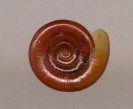families [Physidae], [Lymnaeidae], [Chilinidae] |
||||||||||||||||||||||||||||||||||||||||||||||||||||||||||||||||||||||||||||||||||||||||||||||||||||||||||||||||||||||
Freshwater Molluscan Shells: Pulmonata
families [Physidae], [Lymnaeidae], [Chilinidae]
Family Planorbidae
Generally referred to as "Wheel Snails", "Orb Snails", or "Ramshorn snails", the Planorbidae are the largest family of aquatic pulmonate gastropods, with species present on all continents and most islands. They are sinistral in their orientation, in spite of the fact that some may appear dextral due to the spire being sunken more than the umbilicus. Many of these species harbor the larvae of parasitic worms, particularly southern and Old-World taxa. Some are patelliform or limpet-like (see Freshwater limpets). Banarescu (1990) provides the following classification, here tabulated. Many subgeneric and subspecific names are in use, so for instance, the first specimens pictured are Planorbella (Pierosoma) trivolvis trivolvis (Say, 1817).
Subfamily Tribe Genus Rhodacmeinae Rhodacmea; Southeast North America. Limpet-like. Bulinini Bulinus; Africa, West Asia, southern Europe
Indoplanorbis; Southern Asia
Laevapex; eastern North America, limpet-like.
Gundlachia; South and Central AmericaBulininae Physastrini Isidorella; south and west Australia
Bayardella; localities in Australia
Patelloplanorbis; New Guinea, Limpet-like?
Oppletora; northern Australia
Ancylastrum; Tasmania Limpet-like?
Miratesta; Celebes Is.
Protancylus; Celebes Is. Limpet-like?
Pettancylus; Southeast Asia, Australia, and the Pacific, East Africa. Limpet-like?
Barnupia; north Australia and New Guinea, East Africa, Limpet-like
Ferrisia; temperate North America. Limpet-like
Glyptophysa; southern Australia, New Zealand
Physastra; Australia and New Zealand, New Guinea
Ameriana; North and northeast AustraliaCamproceratini Helisoma North America
Planorbarius Siberia
Camptoceras east and Southeast AsiaPlanorbulini Planorbula, (including Menetus, Promenetus, and Planorbella
of Burch, (1982); all North American.Biomphalarinii Biomphalaria; central Africa and Central and South America
Drepanotrema; South America, AntillesPlanorbinae Planorbini Planorbis; Europe, western Asia, northern Africa
Afrogyrus and Afrogyrorbis; East Africa and Madagascar
Anisus; Europe and West Asia.
Bathyomphalus; Europe and much of Siberia
Choanomphalus; Lake Baikal
Gyraulis; all of both Europe and Africa, except SaharaSegmentini Segmentina; most of Europe and Siberia
Hippeutis; most of Europe through central Siberia
Lentorbis and Segmentorbis; Central and Southern Africa
Polypylis; coastal eastern asia and Japan
Helicorbis; East and Southeast AsiaAncylini Ancylus; Northern Hemisphere, discontinuous, Limpet-like Uncertain Neoplanorbis and Amphigyra; southeastern North America

Planorbella trivolvis (Say, 1817) Eastern and Central Canada and Northern U.S. Four views of two specimens:
1) Apertural view with left side to left. 2) Left or spire side of shell. 3&4) Right, or umbilical side
Planorbella scalaris
(Jay, 1839) FloridaHelisoma anceps
(Menke, 1830)
Eastern, central, and
northern North America.Planorbella campanula
(Say, 1821)
North-Central North America
Planorbella tenuis (Dunker, 1850)
Southern United States, Mexico; ponds.Biomphalaria havanensis (?) (Pfeiffer, 1839)
Southern U. S., Central America, West Indies; ponds.
Snail shell obtained from a breeder in Belgium, courtesy of
Gerald Depaus. Possibly Planorbella occidentalis
(Cooper, 1870) or Planorbella ammon (Gould, 1855)

Drepanotrema lucidum (Pfeiffer)
West IndiesAnisus filiaris (Gredler, 1885)
western Asia
Anisus vortex Europe Bathyomphalis contortus
(Linne, 1758) Europe
Hippeutis umbilicalis
(Benson, 1836) x4 (left)
Gyraulis siamensis
(Martens, 1867) x4 (right)Brandt (1974) lists six Gyraulis, one
Hippeutis and three Segmentina
species for the territory of Thailand,
some of which are hosts to
Echinostoma and other parasites.
All are small inconspicuous snails.
Images from Brandt (1974).
Anisus leucostoma
(Millet, 1813).
Hungary. x 6
Planorbis corneus (L., 1758) Europe Planorbid species from a pond in the
south-Central United States, possibly an
aquarium escapee.
Indoplanorbis exustus
(Deshayes, 1834). Sri Lanka. x3
Biomphilaria tenagophila tenagophila
(Orbigny, 1835). Bahia State, Brazil. x 3.
Isidorella hainesii (Tryon, 1866) Victoria, Australia.
Isidorella newcombi (Adams & Angas, 1864)
South Australia.
Glyptophysa gibbosa (Gould, 1546)
Queensland, Australia.
Bulinus senegalensis O. F. Müller, 1781
Africa. Largest specimen is 4.4 mm. Despite the
resemblance of these shells to the Physidae, they
have been included with the Planorbidae in all
sources available.
The name Bulinus was originally applied by
Müller to include Physa snails, and controversy
has existed as to whether "Bulinus" might have
priority for Physa. (Pilsbry and Becquaert, 1927)
Physopsis africana
globosa (Morelet,
1866). Africa, to
20 mm. long.
Black and white
images from Pilsbry
and Becquaert,
1927, courtesy of
the American
Museum of Natural
History
families [Physidae], [Lymnaeidae], [Chilinidae]
Sitemap Home Page.